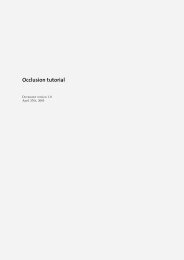mental ray Architectural and Design Visualization Shader Library
mental ray Architectural and Design Visualization Shader Library
mental ray Architectural and Design Visualization Shader Library
Create successful ePaper yourself
Turn your PDF publications into a flip-book with our unique Google optimized e-Paper software.
2.6 Tips <strong>and</strong> Tricks 55• Glass-Liquid interface (IOR=1.33/1.5=0.8)It is evident that in the most common case of an interface with air, the IOR to use is theIOR of the media (since the IOR of air is 1.0), whereas in an interface between two differentmedia, the situation is different.To correctly model this scenario, we then need three surfaces, each with a separatemia material applied:The three interfaces for a liquid in a glass• The Air-glass surface (blue), with normals pointing out of the glass, covering the areawhere air directly touches the glass, having an IOR of 1.5• The Air-liquid surface (green), with normals pointing out of the liquid, covering thearea where air directly touches the liquid, having an IOR of 1.33• The Glass-liquid surface (red), with normals pointing out of the liquid, covering thearea where the glass touches the liquid, having an IOR of 0.8By setting a suitable refr falloff dist <strong>and</strong> refr falloff color for the two liquid materials (toget a colored liquid), the image on the left in the comparison above is the result.2.6.2.7 The Ocean <strong>and</strong> Water SurfacesA water surface is a slightly different matter than a visibly transparent liquid.The ocean isn’t blue - it is reflective. Not much of the light that goes down under the surfaceof the ocean gets anywhere of interest. A little bit of it is scattered back up again doing alittle bit of very literal “sub surface scattering”.To make an ocean surface with the mia material do the following steps:
















